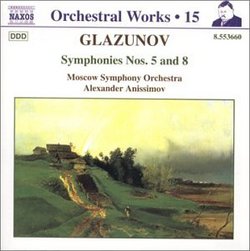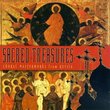| All Artists: Alexander Glazunov, Alexander Anissimov, Moscow State Symphony Orchestra Title: A. Glazunov: Symphonies Nos. 5 & 8 Members Wishing: 0 Total Copies: 1 Label: Naxos Release Date: 10/17/2000 Genre: Classical Style: Symphonies Number of Discs: 1 SwapaCD Credits: 1 UPC: 730099466028 |
Search - Alexander Glazunov, Alexander Anissimov, Moscow State Symphony Orchestra :: A. Glazunov: Symphonies Nos. 5 & 8
 | Alexander Glazunov, Alexander Anissimov, Moscow State Symphony Orchestra A. Glazunov: Symphonies Nos. 5 & 8 Genre: Classical
![header=[] body=[This CD is available to be requested as disc only.]](/images/attributes/disc.png?v=430e6b0a) ![header=[] body=[This CD is available to be requested with the disc and back insert.]](/images/attributes/disc_back.png?v=430e6b0a) ![header=[] body=[This CD is available to be requested with the disc and front insert.]](/images/attributes/disc_front.png?v=430e6b0a) ![header=[] body=[This CD is available to be requested with the disc, front and back inserts.]](/images/attributes/disc_front_back.png?v=430e6b0a) |
Larger Image |
CD DetailsSimilarly Requested CDs
|
CD ReviewsGlazunov: Festive and Earnest Thomas F. Bertonneau | Oswego, NY United States | 05/03/2001 (4 out of 5 stars) "Naxos closes out its cycle of symphonies by Alexander Glazunov (1865-1936) with a disc of the Fifth and Eighth Symphonies (1895 and 1908). I nominate the Fifth as Glazunov's best symphony, the most balanced, the most fecund in its profusion of song-like themes. (Of course, this is rather like picking a single rose from the bunch - the other roses remain quite as beautiful as they are.) In particular, the high-spirited Finale, with its recurrent "bear dance," endears itself to the listener. In the early 1970s, on a Columbia/Melodiya LP, you could hear (was it?) Alexander Fedoseyev conduct this work with the Moscow Radio and Television Orchestra, which, in my memory, was a superb recorded performance. Much more recently, Valery Polyansky conducted both the Fourth and the Fifth for Chandos, with the Russian State Symphony Orchestra, and Yondani Butt offered the same coupling, with the London Symphony, on ASV. Reviewers have complained that Polyansky infuses too little energy into Glazunov's symphonic scores, while they have accorded higher marks to Butt. My unprofessional ear detects only a few slight differences: Polyanksy emphasizes the balletic elements of the symphonies less than Butt, perhaps in an effort to make them more "symphonic," while Butt sees the same works more as suites and thus akin to "Scènes de Ballet" or "From Medieval Times." (Butt's performance of the Sixth is really full of charm.) Alexander Anissimov's approach lies in between Polyansky's and Butt's. In the Fifth, he elicits impressive energy and commitment from his Moscow Symphony players. The opening of the First Movement (Moderato Maestoso - Allegro), in the celli and basses, is appropriately large in measure, with a motto-theme given out by various solo woodwinds in sequence until it finally appears in itsbdefinitive timbre in the solo horn. This music points toward Glière's "Ilya Murometz" of a decade or so later. When the pace quickens, the movement really sails along, with heroic transformations of the motto-theme. The Scherzo, as usual with Glazunov, takes its cues from those of Mendelssohn, but with a Russian accent. The Andante incorporates Wagnerian harmonies, with a menacing figure in the brass. We find ourselves again in proto-"Ilya Murometz" territory. The concluding Allegro Maestoso, in rondo-form, includes that humorous "bear-dance" in the bass-instruments; but many, many moods pass swiftly in review - it's tour-de-force of unexpected juxtapositions. The Eighth in E-Flat shows Glazunov trying to merge the Germanic, Brahmsian type of symphony with the Russian, Tchaikovskian type. Larger in scale than the Fifth (43 as opposed to 35 minutes), the Eighth offers a slightly more serious countenance and makes conspicuous use of contrapuntal and other strict gestures. The major key (as in Beethoven's "Eroica," or Strauss's "Ein Heldenleben"), however, prevents any too-deep descent into over-earnestness: The svelte Slavic melodies are still there as is the glittering variety of the composer's orchestral palette. Glazunov began another symphony but never finished it, so that the Eighth counted as his last. The competition comes from Neeme Järvi on Orfeo, but Anissimov's is a more characteristically Russian, and a much more "loose-limbed," reading of the score. All in all - a fine conclusion to Anissimov's cycle. Recommended." The compact disc well worth it! David A. Hollingsworth | Washington, DC USA | 10/28/2000 (5 out of 5 stars) "This is a very worthwhile CD, not only because the performances & the recording quality is thus far the best in the Naxos series of Glazunov's orchestral works. It is also because the coupling gives us a glimpse of Glazunov's very Russified style in the 1890s as compared to a more progressive, Scriabinesque-oriented style in the post 1900. Typically, Glazunov's Fifth is coupled with his Fourth (both written during the same 1894-1895 time span). The optimistic, heartwarming Fifth Symphony (1895) was written during a relatively peaceful period in Russian history, while the disturbed, more purposeful Eighth was completed in 1906, in the period of political and social unrests. And the differences between the styles are startling. Take the first movement of both the Fifth & the Eighth Symphonies. In the Fifth Symphony (1895), the first movement starts off heavily and with a strong motif pronounced by the brass & strings counteracted by the woodwinds. Soon the movement becomes active, permeated it with the Borodinian sense of epic breadth and poetry (pronounced especially by some glorious harp arpeggios). The climax is Glazunov's own, but no doubt the influences of both Borodin & Rimsky-Korsakov have some imprints on upon it. The lesser lyrical & poetic First movement of the Eighth Symphony (1906) has a greater sense of purpose, however. Its beginning is portentous and even hopeful. But, It's rather disturbed & its' feeling comtemplative (especially at the final bars of the movement). But, shall I pick just one of many examples of how great Glazunov is as a composer, it has to be Mesto movement of the Eighth. In terms of emotional depth, this movement clearly out-rivalled the previous slow movements of his symphonies. Take for example, the beginning bars of the movement. Instead of starting it calm, poetic, and heart warming as Glazunov did in previous slow movements of the symphonies, this one starts off with a forceful, volcanic tutti rather Tchaikovskian in vein (by the strings, then brass with timpani). As the movement processes, the sorrow & melancholy become pronounce and the climax returns to the tutti of the beginning. It's after this point where the movement ended on a very grim, serious note (again, atypical of the composer). But, one should not take away the noble, heartwarming attributes of the Andante movement of the Fifth symphony. It is beautiful & calm, very easygoing in its thematic invention and expression. And again, the harp arpeggios add beauty to the movement well played here. Glazunov, as a great artist would do, abruptly interrupted the soothing melodies sung by the strings & woodwinds with a brass chorale, giving the middle part of the movement a strong sense of symphonic conflict and contrasting material. Thereafter, the movement resumes and ends with the lush sentamentality & warmth. The scherzo movement and the finale of the symphonies are very different in terms of musical outlook & idiom. The scherzo of the Fifth is balletic & sparkling, owing much to Rimsky-Korsakov & Tchaikovsky. The scherzo of the Eighth ("diabolical" proclamed Elena Glazunov-Gunther, the composer's adopted daughter) is angered & fierce, with some hard-earned gaity abruptly interrupted by anxiety & tension. It is unlike any other scherzi written by Glazunov. The finales are also different. In the Fifth, the finale is festive & stunningly virtuosic throughtout. But, in the Eighth, the finale took some time to overcome the pain and the torment and while majestic optimism took over to the very end, it is that optimism quite in a different league from such in Glazunov's other finales of his symphonies. The optimism was not easy to come by, and Glazunov was well aware of that reality. I would not be without the Rozhdestvensky's recording of Glazunov's Eighth with the USSR Ministry of Culture Symphony Orchestra, or the Svetlanov's recording of Glazunov Fifth with the USSR State Symphony (Melodiya SUCD 10-00025-nla). Rozhdestvensky's reading of this masterpiece is truly impulsive and powerful, especially in the Mesto movement. Svetlanov's rendering of the Fifth, though not as delicate as Anissimov or as cultivated as Jarvi's, captured the very slavonic layers behind this appealing score, with the strings soaring and well-blended. But, it must be said that Anissimov's performances of the symphonies with the Moscow Symphony measures up to both Rozhdestvensky and Svetlanov in most counts. They've made strong cases for the symphonies & I greatly admire the delicacy Anissimov brings forth in the first & scherzo movements of the Fifth without over-indulgence. While the Andante is well played with such a chocolate-melting warmth, the Finale could have been performed with a more rhythmic bite & virtuosity as in Svetlanov's recording. Nevertheless, the Eighth Symphony was marvellously performed also, and I'm quite awed at Anissimov's ability to portray the anguish & passion in the middle movements (the scherzo under Anissimov's hand is the best ever on record). The winds especially have a greater sense of involvement and polish, aided by the recording quality, which is spacious, clean, and faithful: the best in the overall Naxos series of Glazunov's orchestral works. Gracefully recommended." Glorious Glazunov... vmzfla | Orlando, Fl. | 02/03/2006 (5 out of 5 stars) "Econonmically speaking; If you wanted to own only one CD representing the underated Alexander Glazunov, this could be it. The Tchaikovskyesque 5th. Symphony is filled with the inventive use of intrumentation and folk themes. It is true to the core Russian Romanticism! The melodic frenzied finale has stuck in my head for over twentyfive years, when I viewed a live concert performance. Composed in 1895 it was the result of an era when different styles were being experimented. In stark contrast the 1906 8th. Symphony(His last completed)exhibits 20th century expansiveness. It is less memorable as far as themes but is masterfully orchestrated and features an incredibly stormy scherzo. The 5th. by no means lacks orchestration, but is compact compared to the 8th. This is a wonderful coupling, with committed Russian performances. The engineering is one of Naxos's best and a real bargain."
|

 Track Listings (8) - Disc #1
Track Listings (8) - Disc #1








